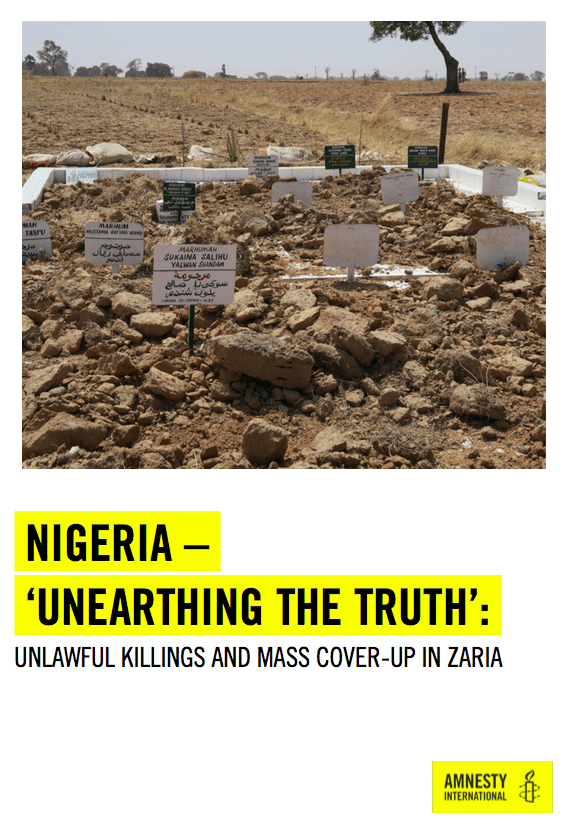Mass slaughter of hundreds of men, women and children by soldiers in Zaria and the attempted cover-up of this crime demonstrates an utter contempt for human life and accountability, said Amnesty International as it publishes evidence gathered on the ground revealing how the Nigerian military burned people alive, razed buildings and dumped victims’ bodies in mass graves.
The report, Unearthing the truth: Unlawful killings and mass cover-up in Zaria, contains shocking eyewitness testimony of large-scale unlawful killings by the Nigerian military and exposes a crude attempt by the authorities to destroy and conceal evidence.
“The true horror of what happened over those two days in Zaria is only now coming to light. Bodies were left littered in the streets and piled outside the mortuary. Some of the injured were burned alive,” said Netsanet Belay, Amnesty International’s Research and Advocacy Director for Africa.
“Our research, based on witness testimonies and analysis of satellite images, has located one possible mass grave. It is time now for the military to come clean and admit where it secretly buried hundreds of bodies.”
More than 350 people are believed to have been unlawfully killed by the military between 12 and 14 December, following a confrontation between members of the Islamic Movement of Nigeria (IMN) and soldiers in Zaria, Kaduna state.
IMN supporters – some armed with batons, knives, and machetes – had refused to clear the road near their headquarters, the Hussainiyya, for a military convoy to pass. The army has claimed that IMN supporters attacked the convoy in an attempt to assassinate the Chief of Army Staff. IMN members deny this.
Following an initial confrontation the military surrounded other locations where IMN supporters had gathered, notably at the residential compound of IMN leader Ibrahim Al-Zakzaky. Some people were killed as a result of indiscriminate fire. Others appeared to have been deliberately targeted.
All available information indicates that the deaths of protestors were the consequence of excessive, and arguably, unnecessary use of force.
Children injured and killed
Zainab, a 16-year-old schoolgirl, told Amnesty International: “We were in our school uniforms. My friend Nusaiba Abdullahi was shot in her forehead. We took her to a house where they treated the injured but, before reaching the house, she already died.” A 10-year-old boy who was shot in the leg told Amnesty International how his older brother was shot in the head as they tried to leave the compound. “We went out to try to shelter in a nearby house but we got shot.”
Shot and burned alive
On 13 December, two buildings within Ibrahim Al-Zakzaky’s compound, one of which was being used as a makeshift medical facility and mortuary, were attacked by soldiers. Alyyu, a 22-year-old student, told Amnesty International that he was shot in the chest outside the compound and was taken inside for treatment: “There were lots of injured people in several rooms. There were dead bodies in a room and also in the courtyard. Around 12-1pm soldiers outside called on people to come out, but people were too scared to go out. We knew they would kill us. Soldiers threw grenades inside the compound. I saw one soldier on the wall of the courtyard shooting inside.”
One mother described a phone conversation with one of her 19-year-old sons before he was killed alongside his twin brother and their step brother and sister in the compound. “They are shooting those injured one by one,” he told her.
As soldiers set fire to the makeshift medical facility in the compound that afternoon, Yusuf managed to escape despite serious gunshot wounds: “Those who were badly injured and could not escape were burned alive,” he told Amnesty International. “I managed to get away from the fire by crawling on my knees until I reached a nearby house where I was able to hide until the following day. I don’t know how many of the wounded were burned to death. Tens and tens of them.”
Footage believed to have been shot on mobile phone by IMN supporters after the incident shows bodies with gunshot wounds as well as charred bodies strewn around the compound.
Cover-up
After the incident the military sealed off the areas around al-Zakzaky’s compound, the Hussainiyya and other locations. Bodies were taken away, sites were razed to the ground, the rubble removed, bloodstains washed off, and bullets and spent cartridge removed from the streets.
Witnesses saw piles of bodies outside the morgue of Ahmadu Bello University Teaching Hospital in Zaria. The hospital’s Chief Medical Officer told Amnesty International that the military sealed off the area around the morgue for two days. During that time he saw army vehicles “coming and going”.
A witness described to Amnesty International what he saw outside the hospital mortuary on the evening of 14 December: “It was dark and from far I could only see a big mound but when I got closer I saw it was a huge pile of corpses on top of each other. I have never seen so many dead bodies. I got very scared and run away. It was a terrible sight and I can’t get it out of my mind.”

